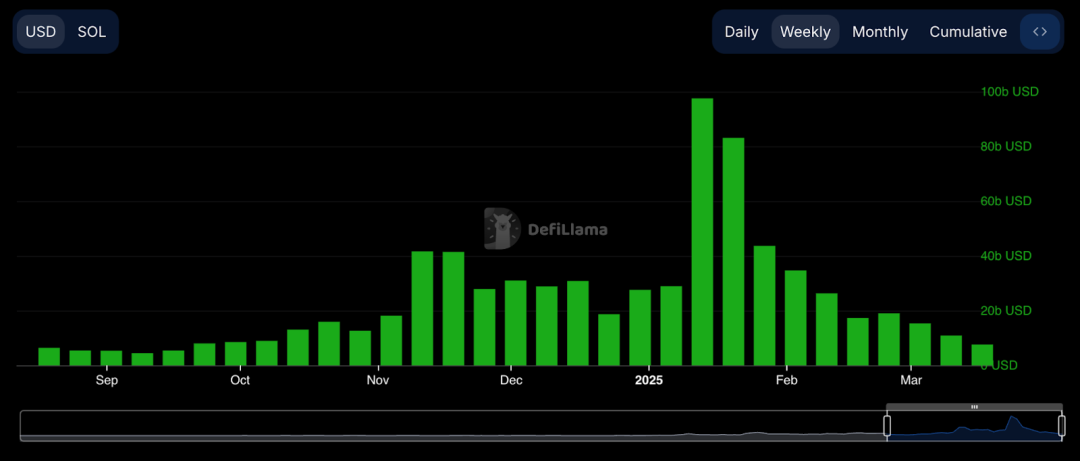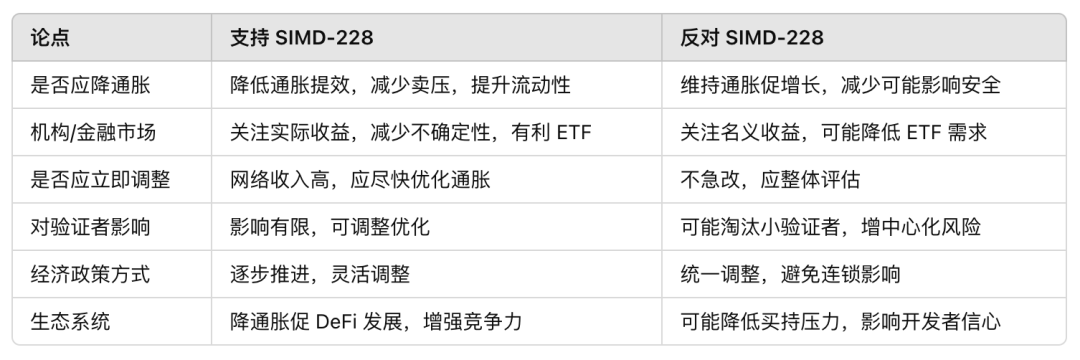Author: Danny @IOSG
summary
SIMD 0228, an important decision that has recently touched the hearts of all Solana ecosystem participants, was not passed. The voting participation rate hit a record high in Solana history (close to 50% of the total token supply), but the final support vote ratio was not enough to reach the supermajority threshold (66.67%) required for passing.
The background of such a proposal is that Solana has gradually calmed down from the on-chain frenzy brought by Memecoin after Trump issued the coin. The weekly trading volume has retreated from nearly $100b at the beginning of the year to no more than $10b, a decrease of 90%, which is lower than the trading volume in the early days of Memecoin.

Along with Memecoin, Solana became the most successful public chain in this cycle. When the Memecoin cycle gradually declined, Solana also faced the stage of transformation and re-positioning. It was at this time that Multicoin, Solana's largest capital supporter, proposed Proposal 0228. As soon as the proposal came out, it attracted fierce debate in the community. Twitter became the main battlefield, and different stakeholders argued for their rights and voted openly until the last moment of the voting.
During the proposal debate, we can see many shadows of the past when the Ethereum community was promoting changes. The proposal itself has a short window, and many long-term considerations and short-term solutions are proposed. Of course, there are also many interests that are not easy to express directly. But its transparency allows us to see the current attitudes and strategies of many Solana leaders.
Although the proposal was rejected this time, the proposer, Tushar from Multicoin, still called it "a victory" because of the high participation rate in the vote and extensive community discussion, which demonstrated Solana's decentralized governance capabilities.
Who is behind the Solana governance proposal? What does it mean? Why did it fail? Is the procedure fair and successful? Let’s take a look at it one by one.
SIMD 0228 - A hasty proposal
What is Proposition 228?
228 By dynamically adjusting the inflation rate according to the pledge rate, the goal is to maintain a 50% pledge rate and reduce the issuance rate of SOL in the long term.
Solana's current inflation model is a curve that gradually decreases over time. At the launch of the mainnet (March 2019), an inflation rate of 8% was set and has decreased over time. The current inflation rate is about 4.8%, and the long-term target inflation rate is 1.5%-2%.
If this proposal is passed, short-term staking returns will decrease (based on the staking rate between 1% - 4.5%), and the long-term inflation rate will approach 1.5%.
The current pledge rate is 70%. Therefore, if 228 is passed, the income from staking SOL will be reduced in the short term, the issuance will be reduced in the long term, and the pledge yield will be adjusted in real time according to the pledge rate.
Unlike SIMD 0123, where validators can choose whether to opt in, 0228 is mandatory, which means that once it is launched, the interests of all stakers will be affected.
Supportive voices
This proposal was proposed by Tushar and Vishal from Multicoin Capital and supported by Max from Anza and former Consensys researcher. The reasons include:
#Reduce unnecessary token issuance and reduce inflation costs
Solana's current fixed inflation model is a "dumb emissions" model because it does not take into account the actual economic activity or security needs of the network. At an inflation rate of 4.8% in early 2025, there will be approximately $3.82 billion worth of new issuance per year (based on a market cap of $80 billion). This high inflation is essentially a dilution of SOL holders, especially with the current staking rate as high as 65.7% - the network is already fully secure.
Passing this proposal means that the concept of staking will shift from "overpayment to ensure security" to "finding the minimum necessary payment."
Interestingly, this is exactly the argument that some KOLs in Solana used to attack the economic security of Ethereum, namely that too many assets are supporting the economic security of an economy that is regarded as a “meme”.
#Release capital and promote the development of DeFi ecosystem
The current high pledge rate (65.7%) has led to a large amount of SOL being locked up, inhibiting the flow of capital in the DeFi ecosystem. Kamino founder Marius pointed out that "staking encourages hoarding but reduces financial activity." This is similar to the principle that high interest rates in traditional finance inhibit investment.
It is worth noting that the main supporters of the Defi protocol on Solana are also the VCs who put forward the proposal, so releasing liquidity into Defi is also a motivation that cannot be ignored.
#Reduce the "leaky bucket effect" and enhance ecosystem autonomy
The leaky bucket effect refers to the value within the ecosystem, which is greatly worn out and leaked during economic activities. Since the newly issued SOL is regarded as ordinary income and is subject to tax in the United States, the amount of additional issuance generated by inflation will be proportional to the value extracted from the entire ecosystem. For Solana, approximately $650 million in taxes and approximately $305 million in exchange commissions have flowed out of the ecosystem.
From the first principles, Solana has essentially entered a stable stage, and the inflation model set up in the early stage has become unreasonable. The development of the chain is based on improving economic activities, and the inflation plan should also be improved accordingly.
Chris, a partner of Placeholder, concluded that the real benefits should come from the spillover of demand to supply, and the fixed inflation setting that is conducive to cold start should not be used. In the long run, the arguments of the supporters do make sense. When a public chain ecosystem passes the cold start stage, it naturally needs a more ideal economic system to promote economic development.
Opposing voices
A group led by Lily, the chairman of the Solana Foundation, opposed the adoption of this proposal. The main point of contention is whether to implement this proposal in such a short period of time, rather than a longer period of time. Proposals with great changes in asset attributes will affect participants in different links (network layer engineers, product layer developers, and economic layer institutions). Currently, most of the discussions are among core network layer personnel and product layer personnel, and there are fewer voices from product layer and institutionally dominated economic layer groups that are farther away from the information channel. Therefore, it should not be rushed to pass before the argument is not perfect.
Many opponents have raised concerns about the loss of small validators. Small nodes are inferior to large nodes in terms of scale effect and bargaining power, so the reduction in inflation will first eliminate these small nodes, which will hurt Solana's decentralization. However, after talking with some of Solana's nodes, I found that most nodes still support passing. The reason is that Solana has a lot of subsidies and everyone believes more in the value of SOL itself after continuous improvement. I can feel the centripetal force of the Solana community, which is a digression.
Obviously, both parties are dissatisfied with the current inflation pattern and believe that it needs to be improved. The point of contention is whether it should be implemented hastily within two weeks.
In addition, there may be some considerations of interests. The simplest one is that a large number of SOL holders, especially those who can obtain higher returns from the non-staking ecosystem (Defi), naturally do not want inflation to continue to remain at such a high level. The standard portrait here is the VC behind Solana and the projects it supports.
An important adoption of Solana at present is in the institutional direction, including ETFs and more traditional institutional use cases. So the parties involved in promoting institutional adoption will definitely be opposed. For institutional adoption, whether the passage of SIMD is a positive is controversial. Supporters believe that traditional institutions are more averse to high-inflation assets, while opponents believe that traditional assets have greater uncertainty concerns about assets with dynamically changing inflation rates.

Here, I think that the uncertainty of the mechanism may hinder the adoption of institutions. Institutions can evaluate the asset attributes under the mechanism, but if the mechanism keeps changing, it will hinder the evaluation of institutions. Therefore, for institutions, they should either pass it quickly or wait until the adoption is initially completed before jointly negotiating. At this time, there are more conflicts of interest, which may make it more difficult to pass.
Why now?
This raises a question: why should such a proposal be introduced and promoted so hastily?
Perhaps Solana still has a large amount of transaction volume in the residual heat of the meme, which causes the current node fees and MEV income to remain high, so the adjustment of the staking mechanism will not usher in too much controversy. In 2024, Solana's MEV income totaled US$675 million, and there was a clear upward trend. The MEV income of nodes in Q4 even exceeded the inflation reward. For this reason, nodes are currently relatively less sensitive to inflation income in the short term. If the Solana chain is completely cooled down, the income caused by this proposal will be even worse, which will inevitably cause opposition from the staking community.
Solana's Restaking is about to kick off, and Renzo, Jito, etc. have already begun to show signs of success. Throughout the history of Ethereum, the emergence of liquidity staking and Restaking will bring huge subsidized benefits to staking and validators, and can also reduce the concerns of nodes about inflation rewards.
The Ethereum Foundation also proposed a proposal to improve the inflation curve in the middle of last year, similarly anchoring the pledge rate to a fixed ratio to reduce excessive pledges. The argument put forward at the time was that under the premise that economic security was far from sufficient, it was hoped that more liquidity would be released while reducing the role of LST such as Lido ETH as a substitute for ETH.
After the proposal was put forward, it also triggered a brief discussion. That was when the OGs re-examined the economic mechanism of Ethereum's POW after the POS transformation. The proposal itself and the discussion process both put forward a lot of calculation and deduction support, but in the end, the proposal was not promoted without clarifying the theoretical basis. Ethereum's economic argument may provide some reference for 228, but the opposition it received also reflects the difficulty of passing such a proposal to "cut" interests.
The final result is reasonable. Perhaps under the auspices of the foundation, the validators formed a bearish view of the proposal and worried about institutional adoption. Or perhaps the decision was indeed too hasty, resulting in no consensus among the validators and a split vote. Or perhaps the small validators reached a consensus on short-term income pressure and collectively chose to oppose it. Broad discussion does not necessarily mean deep discussion, and shallow discussion will lead to disagreements. The hastily promoted proposal also reflects the current unclear positioning of the Solana chain itself, the unclear stages, and the consensus pains on what to do next after the memecoin supercyle.
The governance process is a victory
Although this proposal was hastily put forward, a very transparent and open discussion broke out in just a few weeks. Both sides spoke out on Twitter, without a middle ground, and directly gave their approval or disapproval and provided their arguments. This discussion mode allowed everyone to understand the considerations of both sides. At the most intense moment, a Space was even created, where the relevant parties expressed their opinions.
Another highlight is the acceptance of the community's voice. A large number of Solana project owners/builders' pertinent suggestions on Twitter have been responded to and included in the discussion of Space. Proposals are no longer obscure formulas, but have become the voice of each community and are being discussed. One point of criticism about voting is that stakers cannot directly participate in the vote, which also brings about self-contradictions among many large nodes - how to coordinate the opinions of all stakers and make the final decision. This is a problem that all public chains need to solve, and Solana has illuminated this problem for the first time.
The proposal attracted 74% of the staked supply, still demonstrating a high level of community participation. SIMD’s clear voting mechanism and passing threshold make the decision-making process clearer and more predictable. In contrast, Ethereum’s proposal decision-making process is relatively vague, relying mainly on discussions and consensus among core developers, and lacks a formal voting mechanism.
Finally, the efficiency of the proposal. Although we always criticize it for being too hasty, the proposal took no more than two months from proposal to voting to completion. It makes people have to sigh at the efficiency of this ecosystem from top to bottom. This is also the reason why Tushar thinks this is a victory.
Conclusion
Overall, the SIMD228 proposal shows that after the prosperous period of innovating the asset issuance model, Solana has entered the decision-making stage of institutional adoption and continued construction of on-chain consumer applications. The contradictions in the distribution of interests are the turning point of the whole incident.
Supporters also need to take advantage of this prosperous stage of on-chain activities to quickly promote reforms with little friction, but it seems too hasty, resulting in intense but insufficient discussions, insufficient support and education for small validators, and insufficient consensus among validators. The life cycle of the proposal is very short, and this process also reflects the execution and openness of the Solana ecosystem, which is an excellent governance case worthy of learning for all ecosystems.














